
Are Exact-Match Domains (EMDs) in Decline?
One of the great, ongoing debates of SEO (#4 of 673) is the influence of Exact-Match Domains (EMDs) on rankings. Part of my goal in launching MozCast was to collect historical data that would allow us to put some of these contentious questions to the test, and now that we have a few months of data, I thought it would be interesting to dig into the EMD question.
Over the last couple of years, our large-scale correlation data here at SEOmoz has shown a declining impact of EMDs on ranking:
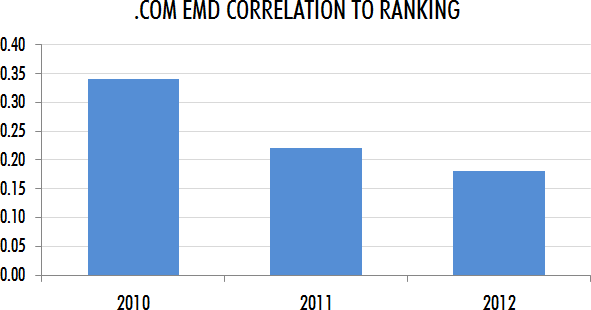
This graph is based only on .com domains and, as always, correlation does not imply causation, but the trend certainly suggests that EMDs are weakening. The MozCast data only goes back to April 2012 currently, but that timeframe covers the Penguin update and other major changes this year, so let’s see how it compares to the year-over-year trend.
Overall EMD Influence
Let’s start simple – across the MozCast data set (Top 10 X 1,000 keywords = 10K* URLs), what percentage of rankings are held by EMDs? In this case, I stuck to a very strict definition: if the keyword is “buy widgets”, then only “buywidgets.tld” (any TLD) counts as an exact match. Here’s the data back to April 4, 2012:
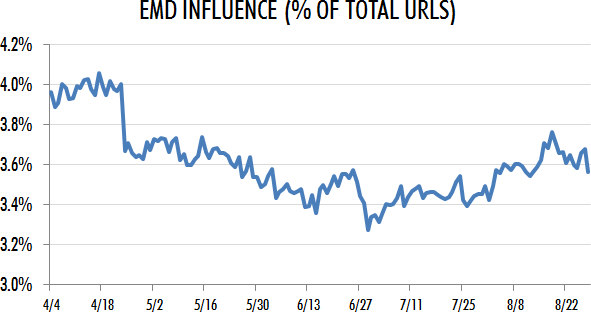
First off, notice that this is a pretty narrow range – over 4-1/2 months, EMDs represent from just under 3.3% to almost 4.1% of total rankings in the data set. On average, EMD influence has declined slightly in the past few months, with a solid drop after the Penguin update, but that drop has recovered somewhat since June.
*Now that 7-result SERPs account for ~18% of the data, the total count is closer to 9,500 URLs.
Correlation vs. Causation
Let’s get this out of the way – just because EMDs hold less spots in the top 10, that doesn’t necessarily mean that Google has turned down the “volume” on EMDs as a ranking factor. It simply means that less EMDs are ranking overall, and that could have many explanations. What we’ll be looking at here is patterns over time, to try to tell more of the story.
Penguilation vs. Penguisation
Likewise, Penguin correlation is not Penguin causation. I don’t think that Penguin directly targeted EMDs. I suspect that, by targeting some forms of spammy anchor text, Penguin disproportionately hit EMDs. Many people who use EMDs solely for ranking purposes are also aggressive with exact-match anchor text. The EMD drop was probably collateral damage.
EMD Influence on Ranking #1
The last graph covered EMDs anywhere in the Top 10, but what about the EMDs just occupying the #1 spot? Have they fallen harder than overall EMDs? Here’s the data on #1 ranking EMDs only:
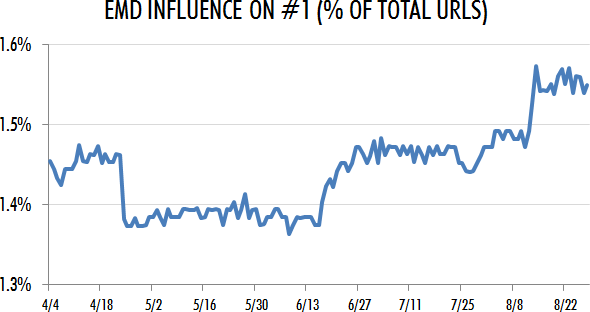
Again, the Y-axis is scaled to amplify differences. While EMDs in the #1 spot also took a hit after Penguin, the picture looks very different around mid-June. EMDs ranking #1 not only recovered their previous influence, but they’ve actually gained SERP-share over the past couple of months. Some of the August spike may be related to the launch of the 7-result SERPs. If the number of total URLs decreased, but the EMDs in #1 remained constant, those EMDs would account for a higher percentage of total URLs.
Overall PMD Influence
My definition of an EMD was pretty strict. What if we looked at the data for partial-match domains (PMDs)? I took a more liberal approach here – for the keyword phrase “buy widgets”, any of the following counted as a partial match, by my definition:
- buywidgetshere.com
- webuywidgets.com
- buywidgets.example.com
- www.buy-widgets.com
In other words, as long as “buywidgets” or “buy-widgets” appeared anywhere in the root or sub-domain, I counted it as a partial match. I excluded all exact matches, to separate the influence. Here’s the data back to April 4th:
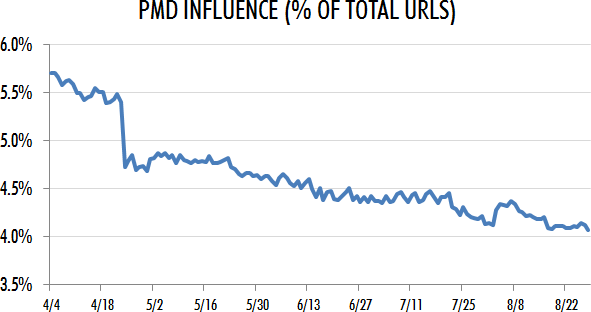
PMDs accounted for slightly more of the mix than EMDs (not surprisingly), but here the pattern is much clearer. Ranking for PMDs suffered a serious decline after the Penguin update and has only continued to fall.
Good EMDs Are Good
Not all exact-match and partial-match domains are created equal. Penguin hit both EMDs and PMDs pretty hard, because too many people were (and are) still over-relying on them for ranking. The problem is that Google can’t just pull the plug on EMDs. Many brands naturally use EMDs, and it’s perfectly reasonable to buy a domain that matches your name. Instead of just changing how domains impact ranking, Google is targeting spammy signals around EMDs and PMDs. For example, Penguin probably targeted aggressive exact-match anchor text. If your website is “casinoviagrarealestate.com” and 90% of your anchor text is “best casino viagra real estate”, you probably took a hit. It wasn’t because you had an EMD – it was because your EMD was part of a low-value approach.
Should You Dump Your EMD?
In a word: No. You should be careful about combining obviously keyword targeted EMDs and PMDs (“buy-casino-viagra-mortgage.me”) with other aggressive tactics, like large amounts of exact-match anchor text, but for the most part you aren’t going to get penalized simply because you have an EMD. There are some extreme Penguin cases where something as drastic as a new domain may be required, but for the most part this is a gradual change in Google’s attitude. I think EMDs are going to count less over time, but EMDs are also a natural part of the ecosystem.
Should You Buy an EMD?
That’s a bit tougher question. If you’re a brand with a unique name, then yes, absolutely, buy yourname. com, etc. If you’re simply using a domain for keyword value, then I think you have to be a little careful and consider your long-term game plan. If you over-rely on that EMD or PMD, you’re likely to pursue other spammy tactics and ultimately be disappointed as Google gradually lowers the volume. I don’t think buying an EMD carries a large amount of risk, but I’d considering your overall branding strategy. An EMD might be an SEO tactic, but it’s just one small factor of many – it’s not a strategy. You also have to weigh the costs and benefits - finding a short, unregistered .com is one thing - buy it and you can decide later how and if to use it.
As for clearly low-value PMDs, like long, hyphenated strings, I’d avoid them. Paying $25K for a hyphenated, seven-word .net is just throwing away money that could be spent on real marketing. It’s not just about declining SEO value – it’s also a matter of perception. If I see six-keywords-strung-together-with-dashes.net and it leads to a slapped together, $75 template site, I see a site I’d never do business with. The tiny uptick in SEO value you might get isn’t worth it. Invest in a brand and start building it. The benefits will go far beyond SEO.
Epilogue #1 - Hyphenated PMDs
A couple of people asked in comments whether the decline in PMD influence was due primarily to Google devaluing hyphenated domains. Teasing that data out was a bit tougher than I expected, but I was finally able to do it. This is a graph of just the non-hyphenated PMDs (excluding "true" EMDs):
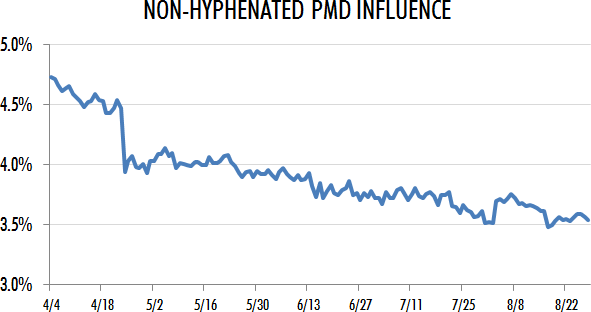
The pattern here is pretty similar to the overall PMD pattern - a sharp Penguin drop, followed by steady decline. So, what about the hyphenated domains only?
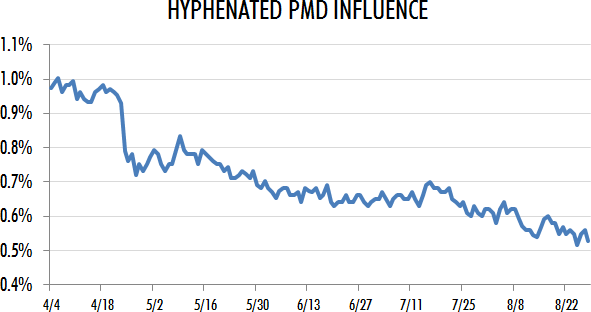
The pattern looks pretty similar - it doesn't appear that this decline is a result of Google specifically targeting hyphenated domains. It is interesting to note that, while the curve looks similar, hyphenated PMD influence dropped from around 1.0% of tracked results to just over 0.5%. By my metrics (and, let's be clear, this is just one way of many to slice the data), hyphenated PMD influence has been cut in half in just a few months.
Epilogue #2 - EMD TLDs (.com vs. other)
One other question came to mind after I wrote the post - how did .com EMDs fair vs. other TLDs? Here's a graph of just the EMD influence for .com's (across the entire Top 10):
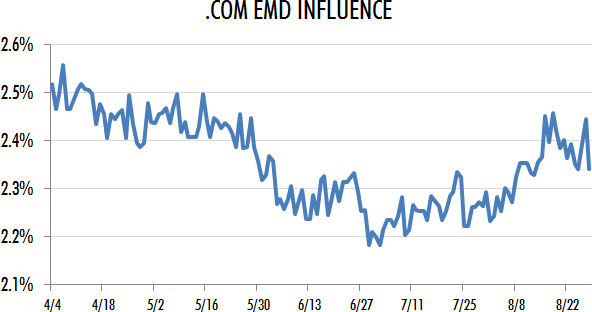
Interestingly, while EMDs declined a bit into June and then recovered, there's no clear Penguin drop. That automatically begs the question: were the non-com TLDs hit hard after Penguin? Here's the EMD influence data for the other TLDs:
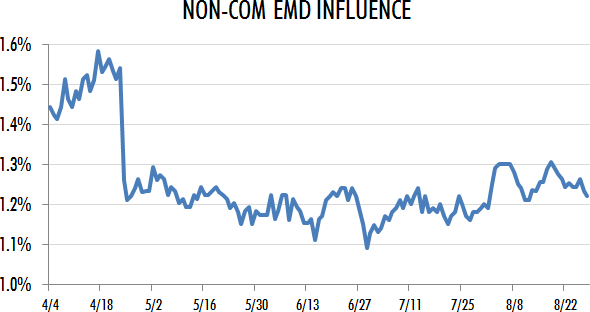
The answer seems pretty clear - the non-com EMDs experienced a sharp post-Penguin drop, and their recovery has been much more anemic. Again, keep in mind that there's a lot of correlation at play here - big brands tend to have .com's, and people who settle for other TLDs may be at a disadvantage for other reasons or could be pursuing lower-value tactics. This doesn't indicate that Google has specifically targeted other TLDs - only that .com's have weathered the storm better, whatever the reason.




Comments
Please keep your comments TAGFEE by following the community etiquette
Comments are closed. Got a burning question? Head to our Q&A section to start a new conversation.